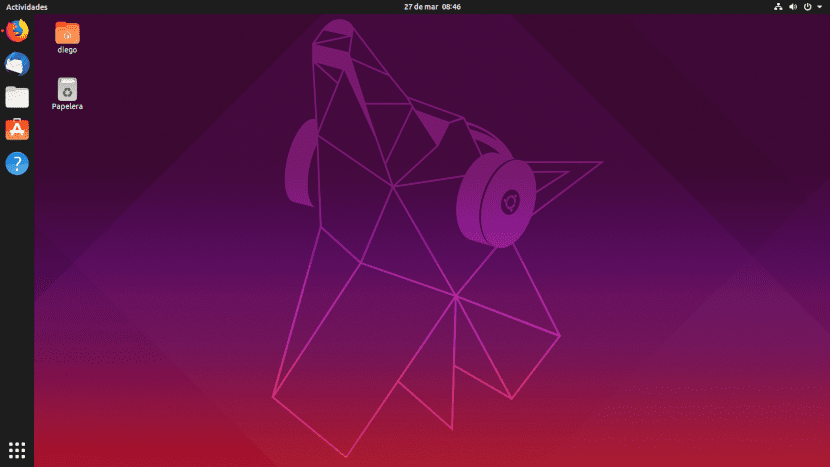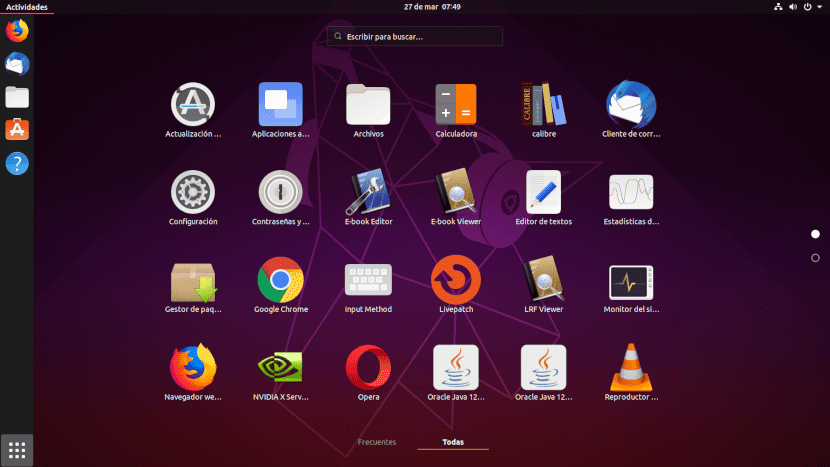
Ubuntu 19.04 comes with the Yaru theme and a new wallpaper.
On April 18, the first version of Ubuntu 2019 will be launched. I'm going to say it before it comes out. Ubuntu 19.04 does not contribute anything.
True, there is a new (and horrible) desktop wallpaper, a new set of icons, and newer versions of the Linux kernel and pre-installed software. But that doesn't differentiate it from the rest of the releases this year. And what made Ubuntu different was precisely bring something innovative in each version.
But to Canonical no longer interested in home users.
A Little History
Ubuntu was one of the first major distributions in bet on live cd. Its popularity grew because in the days when very few had Internet connections they sent the installation cd's to everyone. It was easy to install multimedia codecs and proprietary drivers. You could even install Ubuntu without leaving Windows with a program that came with the cd.
Canonical He dreamed of being the Apple of the Linux world. Fedora and OpenSUSE were the test beds for Red Hat and Novell. Community distros like Debian or Archlinux were on something else. Ubuntu was the choice for home users.
This is the moment when some of you stop reading and go to the comment form to remind me that Mandrake was the first distribution focused on the home user. It's true, but I'm talking about something beyond graphical installation wizards. I'm talking about a distinctive wearing experience.
The utopia of convergence
Each Ubuntu release provoked a pitched battle between Ubuntu fans on the one hand, with defenders of the purity of free software, and on the other with those who said that there was actually already another distribution that had done the same. It hasn't happened for years.
I am one of those who think that the big mistake of Linux was not developing its own hardware. Users have depended for years on reverse engineering and the goodwill of manufacturers. Today, distributions like Manjaro and KDE Neon have agreements with notebook manufacturers and Dell manufactures Ubuntu computers. But when Canonical decided to bet on making its own hybrid device, it was a novelty.
Edge was a smartphone / pc. By itself it was a mobile phone like any other modern phone. By connecting it to a monitor and keyboard, it transformed into a desktop computer. The user interface was adapted to the circumstances. Although crowdfunding was a success the first few days, it did not raise enough.
The return to GNOME

Some Ubuntu 19.04 icons were redesigned and support for third-party application icons was improved.
Unity, the desktop created to replace GNOME 2, divided the waters. Some of us love it at first sight, others have changed distribution. Not even GNOME 3 generated so much controversy.
The original version allowed to view social networks, listen to music and search both on the computer and online without having to open applications. A revamped software center it allowed software developers and publication authors to sell their products.
However, Unity was losing functionalities. A security problem took away the ability to see social networks on the dashboard. The documentation for creating applications was confusing and the development environment created by Canonical (Based on QT Creator) failed often. If you were looking for support in AskUbuntu (which was what the documentation recommended), the most likely thing was that they would cancel the question for not complying with any rule.
Canonical's answer was to wait for Unity 8. But Unity 8 was never ready. One day we meet himThe news that Ubuntu was reverting to GNOME and ditching the phones. He had already abandoned his smart TV project.
Almost by chance the Shuttleworth business had become profitable. Corporate interest in the cloud, a field in which the company had pioneered, brought it big customers. On the other hand, the mania of manufacturers for connecting any device to the Internet prompted their version for the Internet of Things.
In anticipation of its launch it was necessary to put a burden on it. That is, my statement of the beginning of the article. No more innovations for home users. Unless they can also be used in the cloud and the Internet of things.
What's in Ubuntu 19.04 Disco Dingo
Let's review the news then? of this new version
new topic
Yaru, the default theme introduced in Ubuntu 18.10 did not support icons for various third-party applications. The regular icons of these applications did not harmonize very well with those of the installed ones. That aesthetic problem was fixed. As well software center icons, trash can and settings panel changed. The desktop background, cas happens with each new version, corresponds to the pet. Or so I guess. If anyone sees any resemblance to a dingo, let them know.
Some say that the desktop looks more and more like the original GNOME than Unity, for my part I can't be sure.
GNOME 3.22
ubuntu not it adopts all the full features of GNOME version 3.22. In some cases this is good for the user. We can still have icons on the desktop and the side panel is permanently present. Conversely, The (much needed) software center enhancements and controls to enable fractional scalling in HiDPl were not included.
Linux kernel 5.0
The great novelty of this version is the support for high-end AMD graphics cards, CPU performance improvements and support for more hardware.
livepatch
Livepatch is a feature that Allows you to install security enhancements in the kernel without the need for a reboot the system. It only works with the extended support versions. In Ubuntu 18.04 there was a tab in the updates application that allowed to activate it. As it was not extended support, version 18.10 did not include it. For some reason they put it back in 19.04 although with a notice that the function is not available.
If you want to know my opinion, because of how interesting this version more than Disco Dingo it should be called Dromedary Dormido.
Although, it's not all Canonical's fault. The desktop computer market doesn't have much to offer anymore. Even the new smartphone models only add cameras or the possibility of folding.
If we want emotion we will have to look for it in Arduino, Raspberry Pi or Nvidia Jetson.
Stability. With that I am very grateful.
Thanks for comment. Stability should be taken for granted, unfortunately this is not always the case.
Well as for the wallpaper it is something personal, I like it and I have it in Debian but obviously as all my funds I change them every so often. On the other hand, in the news, I think that we should not wait too long from Canonical, as you say, the interest is not in common users, but in cloud services ... a shame but if I am wrong, it is a company , and as such they seek to earn money
I love that open source companies make money. But I miss the innovative spirit.
I think that after almost 10 years having a smartphone someone must have already thought of including the keyboard software in some OS (it occurred to me almost 3 years ago!), It cannot be that the cheapest smartphone, the most software old have this feature and no laptop or pc (no OS) offer it.
Linux has an on-screen keyboard in the accessibility options. And I think I have seen that WIndows too.
I was seeing that GSConnect allows you to use the keyboard of the pc on the mobile wirelessly, but I could not get it to work.
The vast majority of users do not look for domestic emotions in an operating system as such, but they want to do their work and for things to work. The desks have reached a level of maturity that does not need to change much at the moment.
You're right, but at this point I don't see myself starting a gardening blog. If there is no news I do not have to write.
I would love to be able to use linux again because of the terminal issue, a few days ago I installed it on my laptop again along with windows but after many problems with the graphics and the trackpad I could not make the external monitor work.
This is one of the reasons why I had to abandon linux, with work I don't have time to start leaving everything working again after each update.
What I don't like about ubuntu is that I can't start a live iso with the proprietary nvidia drivers, I'm obliged to the horrible nouveau, codecs are not installed to play simple audio or video files, only those that are 100% free, that is, no mp3, no flac, no h264 videos less h265, etc., it is a matter of common sense to give the user the opportunity to have from the outset what simply cannot be missing in an OS that wants to be considered modern and functional.
For now I am happy with manjaro cinnamon, and I am not going to change distro.
I was an ubuntu user until 10.04, when I left gnome 2, I switched to debian xfce for a long time, today I prefer a distro with a simple, modern and functional environment, which does not waste my time installing or configuring things that should come pre-installed by default.
There is a way to do it. Burn a pendrive enabling persistence, adding the repositories and installing the drivers. But as you say, having distros that allow you to enable the drivers from the beginning is something that does not make sense.
Excellent text Diego… you know what you are talking about and you know how to write it well. Agree with you. There is only something better than your post ... «your responses to comments». You're great. Thanks.
I already have the check ready for you. Pick it up whenever you want.
I agree, in part, with the post, I have been an Ubuntu user for many years, I have been through Debian and Arch, in Debian updates took forever and the package is a bit old, but stable as a rock, in Arch happens the opposite, you have everything up to date but some update can modify something that changes the stability of the system, or way.
I remember when I was in school and asked for the Ubuntu CDs to install it on my old laptop, everyone looked at me like a weirdo, those times, I longed for new features, new themes, etc, now the present is different, they just settle for leave what works alone and add a different color, secure the market perhaps.
I think Ubuntu got boring, or I've already gotten old, I don't know.